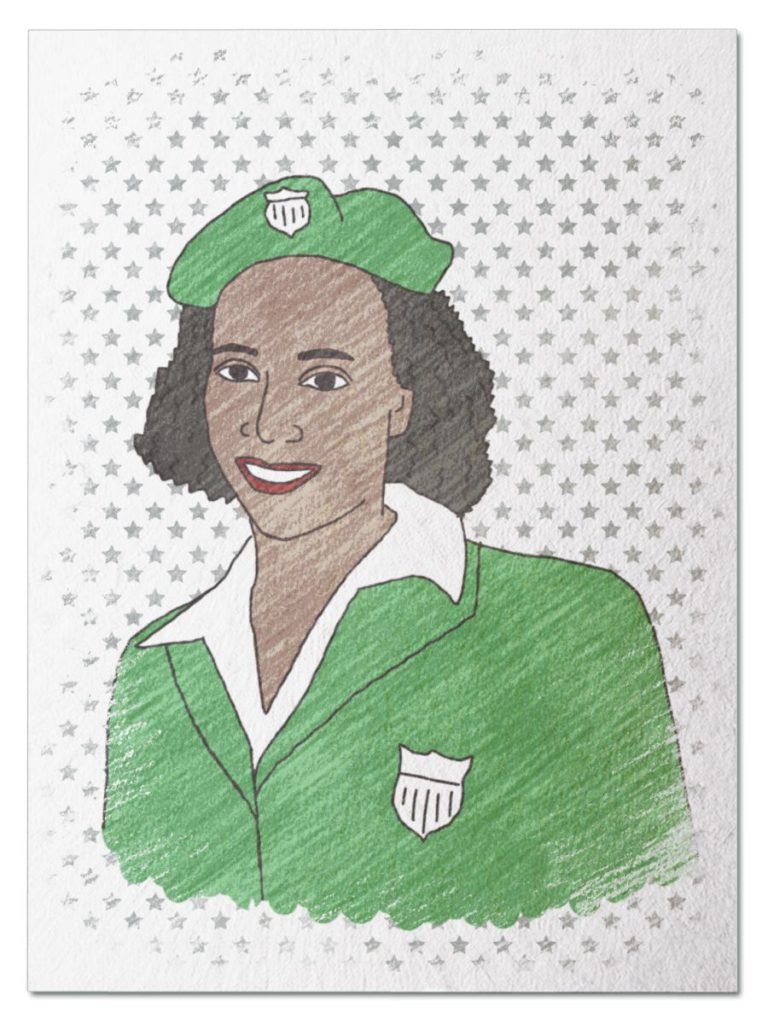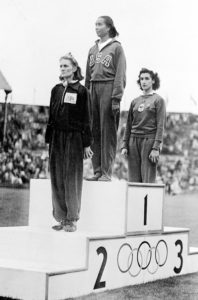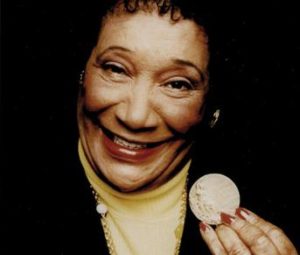
Awesome Athlete
As a girl, she ran barefoot and jumped over fences in the segregated South and received a scholarship to Tuskegee Institute as a result of her natural talent in track and field. Once she received some coaching, she was unstoppable and won 9 national championships before representing her country at the 1948 Summer Olympics. Jump back to war-torn London and witness Alice Coachman make history as the first African American to receive an Olympic gold medal…
Her Ruby Shoe Moment
The Power of the Wand
Her Yellow Brick Road
Brains, Heart & Courage
Glinda’s Gallery
Just the Facts
Her Ruby Shoe Moment
It was day 15 of the 1948 Summer Olympic Games (AKA the “Austerity Games”). Over 80,000 people stood in the rain at Wembley Stadium in London. Alice Coachman sucked on slices of lemon while she waited for her event — they quenched her thirst without making her feel heavy. The high jump was one of the last events of the day.
Finally, it was Alice’s turn at the high jump. She wasn’t nervous — instead, she treated the Games like just another national championship. Alice cleared her rounds easily and made it to the finals. Then, she cleared the bar on her first jump at 5 feet 6 1/8 inches. Alice won the gold!

Alice on the podium at 1948 Olympics, USA Track & Field
Alice didn’t realize she came in first until she looked up and saw her name on the leader board. In fact, her jump broke the Olympic record. Alice’s success finally became real when she received her gold medal from King George IV of England himself. And she made history — Alice was the very first African American to receive a gold medal at the Olympics.
England was still recovering from World War II when it hosted the Austerity Games. The government was nearly bankrupt, with over $15 billion in war debt. Food, clothing and fuel were still rationed. London remained in shambles, with rubble and bombed out buildings. And the infrastructure was a mess (including water and electricity).
The wartime attitude of “mend and make do” permeated all preparations for the Austerity Games. Teams were responsible for all their own supplies, including blankets, sheets, towels, and other necessities. London utilized existing facilities — a greyhound racetrack was converted into the track and field venue; women stayed in college dormitories and men stayed in military barracks; and an army camp served as the Olympic Village for athletes, with tents for everything from a “milk bar” to a hair dresser to a post office to a cobbler.
 Athletes were subject to England’s food rations, although they were given an increased portion (5640 calories per day, the same as coal miners). So various countries provided supplies for the Austerity Games: the Dutch sent 100 tons of fruits and vegetables; the Danish shipped 150,000 eggs; the French brought their own wine; the Czechs sent 20,000 bottles of mineral water; and the Americans brought their own meat and sugar.
Athletes were subject to England’s food rations, although they were given an increased portion (5640 calories per day, the same as coal miners). So various countries provided supplies for the Austerity Games: the Dutch sent 100 tons of fruits and vegetables; the Danish shipped 150,000 eggs; the French brought their own wine; the Czechs sent 20,000 bottles of mineral water; and the Americans brought their own meat and sugar.
The Austerity Games were an eye-opening experience for Alice. Life in London was fully integrated — there were no segregated housing or other facilities for African Americans. She watched people from different countries socializing together, regardless of their race. And she was treated with respect by the other athletes.
Unfortunately, an Olympic gold medal didn’t change Alice’s status in the segregated South. Her hometown held “Alice Coachman Day,” which included a parade in her honor and a celebration in the Albany Municipal Auditorium. The mayor congratulated Alice, but refused to shake her hand. Further, she was forced to leave the auditorium by a back entrance after the celebration ended.
The Power of the Wand
Few people have dominated their sport like Alice — she ruled the high jump for nearly ten years. At first, her Olympic gold medal didn’t seem like that big of a deal. It wasn’t that much different from willing all the national championships. But over time, Alice came to understand that her success was an important symbol for African Americans across the country. And her accomplishment opened the door for other black athletes.
Over the last 70 years, many black athletes have built on the progress made by Alice. Athletes like Olympic gymnast Simone Biles. Simone was introduced to gymnastics when she was 6 years old, and started to train with a coach at age 8. She is the most decorated American gymnast in history, with over 30 medals in world competition. Simone led Team USA’s “Final Five” to victory at the 2016 Summer Olympics in Rio de Janeiro and is hoping to defend the title at the Tokyo Olympics.
Her Yellow Brick Road
Alice knew that college was the key to a successful athletic career. And she knew that her athletic talent was the key to an education. Her family didn’t have the money for college — she needed a scholarship. Thankfully, the track and field coaches at Tuskegee Institute recognized Alice’s raw talent. Alice was offered a scholarship to Tuskegee when she was 16 years old. And she accepted in a heartbeat.

Alice began training and competing over the summer. She even broke high jump records at a national competition before classes started. Despite all her new training, Alice continued to do things her way — her jumping style was completely unique (a cross between the “Western Roll” and “Scissors” style); she always competed barefoot; and she sucked on lemons during a meet.
As part of her scholarship, Alice did whatever was needed in the athletics department — mending uniforms, knitting socks, scrubbing the swimming pool, cleaning the gym, and maintaining the track and tennis courts. In addition to track and field, Alice sang in the school choir, performed with the drill team, and played on the basketball team (which won three national titles while she was there).
During her athletic career, Alice dominated the high jump. She became a national champion at age 16 and held the title for nine years. She was also a good sprinter and broke many high school and college records over the years. By 1946, she was the national champion in four track and field events (50 meter, 100 meter, 400 meter relay, and high jump). In all, she won 34 national titles.
Unfortunately, Alice was at the peak of her career during World War II. As a result, she was denied the ability to compete on the world stage — the Summer Olympics were cancelled in both 1940 and 1944. But Alice never gave up. She attended the Olympic trails and earned a spot on the USA Team, despite a back injury. Even though she was 24 years old and nearing the end of her career, Alice was headed to London for the 1948 Summer Olympics.
Brains, Heart & Courage
Alice grew up in the segregated South during the Great Depression. She was from a large Baptist family, with nine brothers and sisters. Her father was a plasterer — to make ends meet, he traveled to Ohio looking for temporary work. Her mother worked in town as a maid. And the entire family picked cotton on a plantation during harvest time. They each earned 50 cents for every 100 pounds of cotton.
It was tough for a Black girl to participate in athletics back then. There were no organized sports that would include her. She had no equipment or access to training facilities. She had no one to train with. She didn’t even own shoes.

Alice with her gold medal, Albany Herald
But that didn’t stop Alice. She trained by running barefoot alongside the dirt roads. She practiced by making her own equipment — jumping over ropes and sticks, then vaulting over fences. Finally, she made a high bar by tying a string of rags between two trees.
At first, Alice’s parents weren’t supportive of her athletic endeavors. Her mother worried that Alice would break her neck and her father wanted her to be ladylike. But Alice was a tomboy at heart. And she never gave up.
Alice found support in other places, however. Her aunt, Carrie Spry, pushed Alice to dream big. And Cora Bailey, her fifth grade teacher at Madison Elementary School, encouraged Alice’s goal to become an athlete.
Eventually, Alice caught the eye of the boys’ track coach at Madison High School. And he saw potential in her. Harry Lash took Alice under his wing, teaching her proper technique and allowing her to use the training facilities. Before long, college scouts began to notice Alice. And it was just the break she needed.
Glinda’s Gallery
Just the Facts
- Alice was born November 9, 1923 in Albany, Georgia. She was the fifth of 10 children.
- Alice attended Tuskegee Institute from 1939-1946, in both its high school and college. She graduated with a degree in dress-making in 1946. Then, she attended Albany State College and earned a BA in home economics.
- Alice competed in the Amateur Athletic Union (AAU) Women’s National Championships from 1939-1948. She won the national championship in the high jump for 9 years straight. She also won national championships in the 50-meter dash, 100-meter dash, and 400-meter relay.
- Alice was the only African American to be named to 5 All-American teams (50 meter, 100 meter, 400 meter relay, 50 yard dash, and national relay team).
- Alice also led the Tuskegee Institute woman’s basketball team to three conference championships.
- Alice surprised many people by retiring from athletics after the 1948 Olympics. She went on to become a physical education teacher and track and field coach for many years. She taught at South Carolina State College, Albany State University, and Tuskegee Institute High School.
- Alice was married twice and had two children, Evelyn and Richmond.
- Alice became the first woman athlete to earn an endorsement — she was a spokesperson for the Coca-Cola company and her face was featured on billboards along with 1936 Olympic track star Jesse Owens.
- Alice was inducted into 8 halls of fame, including the Alabama Sports Hall of Fame, Georgia Sports Hall of Fame, National Track and Field Hall of Fame, and US Olympic Hall of Fame. In addition, she was honored as one of the 100 greatest Olympians at the 1996 Summer Games in Atlanta, Georgia.
- Alice established the Alice Coachman Track and Field Foundation in 1994, to support young athletes and help retired Olympic athletes.
- Alice died July 14, 2014 in Albany, Georgia (she was 90 years old).
Want to Know More?
Essington, Amy. “Alice Marie Coachman (1923-2014).” Black Past. March 8, 2009. (https://blackpast.org/aah/coachman-alice-marie-1923)
Gordon Roulhac, Nellie. Jumping over the Moon: A Biography of Alice Coachman Davis (Philadelphia: privately printed, 1993).
Landsbury, Jennifer. “Alice Coachman: Quiet Champion of the 1940s,” Chapter in Out of the Shadows: A Biographical History of African American Athletes (Fayetteville, The University of Arkansas Press, 2006).
Oral History of Alice Coachman: National Visionary (http://www.visionaryproject.org/coachmanalice/)
